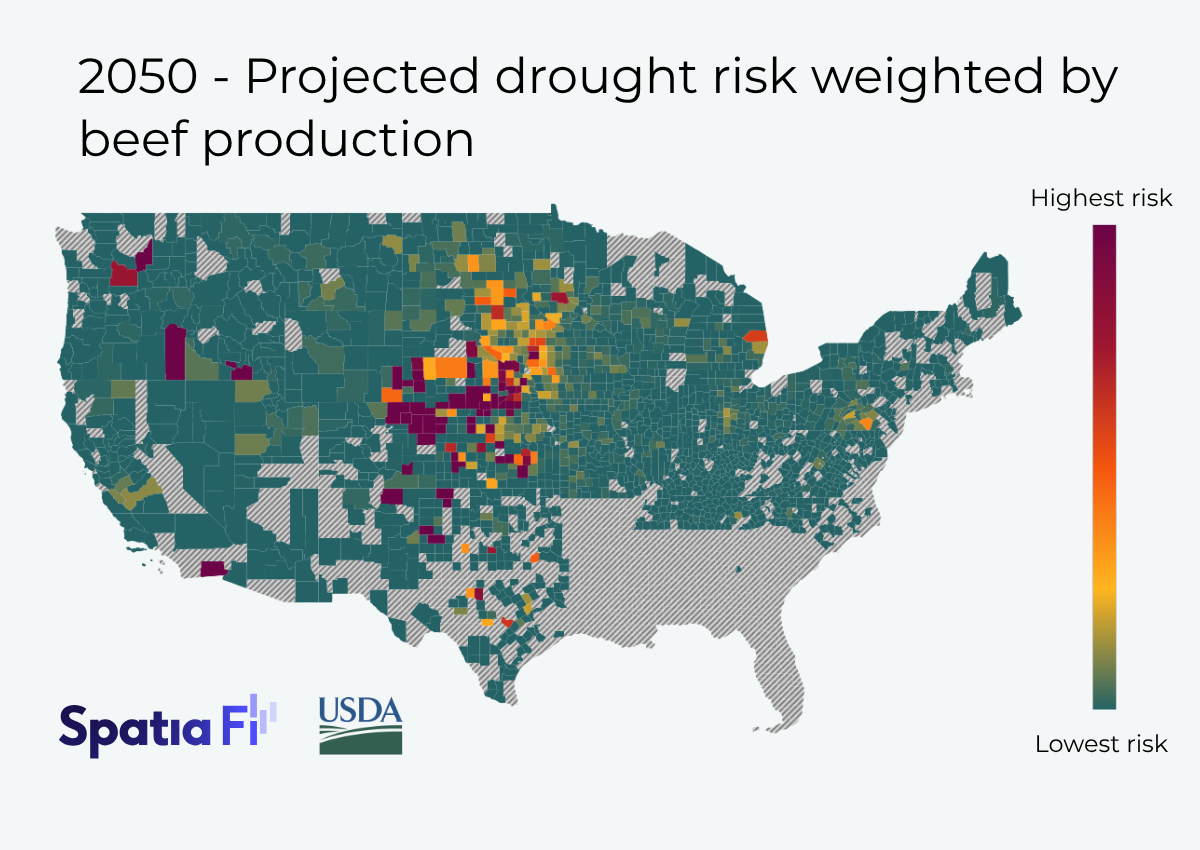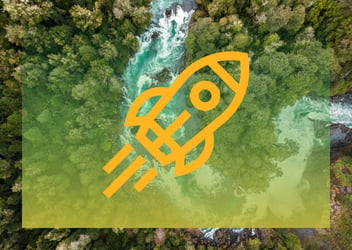Challenge
Like many global retailers, our client was grappling with numerous regulations mandating climate-related risk assessment, including the European Union’s CSRD, Australia's Sustainability Reporting Standards, California Senate Bill 261, and more. However, recognizing detrimental business consequences of extreme weather, ecosystem loss, and other climate-related impacts, the retailer wanted to move beyond high-level regulatory compliance.
The company sought to use quantitative scenario analysis as a foundation to build the business case for adaptation and resilience initiatives. To do this, they needed to understand the granular, location-specific impacts of climate-related risks and opportunities on their global operations and supply chains. More importantly, these impacts needed to be quantified in financial terms and provide decision-quality insights for executives to deploy capital.
Although the team wanted to more proactively manage risks and opportunities, they faced several internal barriers to using scenario planning as a lever for corporate strategy, including:
The organization needed deep, nuanced data spanning its global operations and supply chain. Moreover, this kind of analysis required commodity-specific, global modeling connecting internal data points to external scenarios across a wide range of countries and sourcing regions.
While the retailer had in-house sustainability and finance expertise, they lacked the “missing middle” to bridge the two and quantify the risks, opportunities, and financial implications of various climate scenarios.
Results from the scenario planning exercise needed to directly inform capital allocation decisions, supplier engagement strategies, and operational resilience planning. This meant bringing together teams spanning risk management, finance, water stewardship, sustainability, operations, sourcing, key business unit leads, and more.
Internal sustainability teams were required to provide robust business cases to secure budget for initiatives. With no tangible way to quantify the financial impact of climate-related risks and opportunities (the cost of inaction), teams were limited to relying on the company’s public decarbonization targets to justify investments – often with limited success.
The organization needed deep, nuanced data spanning its global operations and supply chain. Moreover, this kind of analysis required commodity-specific, global modeling connecting internal data points to external scenarios across a wide range of countries and sourcing regions.
While the retailer had in-house sustainability and finance expertise, they lacked the “missing middle” to bridge the two and quantify the risks, opportunities, and financial implications of various climate scenarios.
Results from the scenario planning exercise needed to directly inform capital allocation decisions, supplier engagement strategies, and operational resilience planning. This meant bringing together teams spanning risk management, finance, water stewardship, sustainability, operations, sourcing, key business unit leads, and more.
Internal sustainability teams were required to provide robust business cases to secure budget for initiatives. With no tangible way to quantify the financial impact of climate-related risks and opportunities (the cost of inaction), teams were limited to relying on the company’s public decarbonization targets to justify investments – often with limited success.
With notable subset of agricultural commodities, the company knew it needed to build a credible case for adaptation and resilience investments throughout their value chain. The retailer engaged Earth Finance to conduct a geospatial scenario analysis that quantified risks and opportunities across energy, water, carbon, biodiversity, and other planetary impacts.
Our approach
Earth Finance partnered with the retailer to develop a tailored methodology for conducting quantitative scenario analysis for a variety of planetary impacts, supported by robust geospatial insights from our SpatiaFi platform. Here’s a closer look at our process:
1) Data gathering and stakeholder engagement. To prioritize climate-related risks and opportunities, we used insights from a double materiality assessment. Top impacts, risks, and opportunities included price and supply volatility of priority agricultural commodities, water scarcity, operational impacts from extreme weather, and transition risk of products due to changing market trends and consumer behaviors.
Once priority risks were identified, we engaged various internal teams to gather data needed for future analysis – including historical asset-level climate impacts, water utility bills, commodity spend and volume, country of origin, revenue, supplier material inputs, and more. We also gathered projected earth and economic data from external sources such as the U.S. Department of Agriculture, the U.S. Energy Information Administration, the Consultative Group on International Agricultural Research (CGIAR), and the Network for Greening the Financial System. These data covered transportation energy demand, extreme weather projections, crop yield change projections, and more.
2) Methodology development supported by SpatiaFi. Next, our team designed a bespoke scenario planning approach that integrated internal operational data from physical sites, key supplier data, physical climate risk drivers from the Shared Socioeconomic Pathways (SSP) database, and transition risk drivers from the Network for Greening the Financial System (NGFS). On top of this, the analysis integrated data from SpatiaFi across the following focus areas:
- Asset-level physical risk: exposure of storefronts to current and future physical climate risks (wildfire, hurricane, extreme cold, flooding, heat).
- Water stress: water scarcity across all storefronts and identification of top 200 water stressed sites.
- Commodity risk: county-level mapping of drought risk to forecast commodity yields using inputs like water and animal protein feed intensity.

Illustrative commodity risk mapping powered by SpatiaFi
3) Material risks and opportunities quantification. To communicate climate-related risks and opportunities in the language of business, our team used stochastic “uncertainty” modeling to quantify the probability of financial impacts for each future climate scenario and time horizon. Here’s how risks were quantified across the retailer’s priority focus areas:
- Asset-level physical risk: Increase in financial losses (e.g., expenses and self-insured losses) under modeled future climate scenarios.
- Water stress: Increase in water utility spend and business interruption costs (e.g., annual days of disruption, lost sales of water-dependent product categories, etc.).
- Commodity risk: Percent and volume of future supply at risk for nearly a dozen commodities under various future climate scenarios (mapped against projected business growth).
For example, under the most extreme future climate scenario, our analysis saw significant (>50%) decreases in land suitability for key commodity sourcing regions by 2050, and certain drought-sensitive commodities could see yield impacts approaching 40% of procurement.
4) Integration of insights into adaptation & resilience planning. Using the results of the analysis, our team helped the retailer develop a place-based strategy for prioritizing interventions that better balanced mitigation versus adaptation investments and near versus longer-term actions. The retailer is actively leveraging insights from this project to:
- Build the business case for regenerative agriculture interventions to address supply chain risks to key commodities, particularly animal proteins.
- Enhance operational resilience by implementing water efficiency measures and backup systems in high-risk locations.
- Identify opportunities for market differentiation through supplier engagement capabilities and potential new business model opportunities.
Project outcomes
Our retail client now has location-based, asset-level insights on climate-related risk and opportunity across its operations and agricultural supply chains – helping them to move beyond compliance and toward strategic decisions that can secure their supply chains and build long-term competitive advantage.
Following this project, the team is equipped to:
- Gain executive buy-in on targeted adaptation & resilience investments.
- Integrate planetary risk and opportunity into core business processes.
- Unlock competitive advantage and capitalize on changing consumer preferences.
- Future-proof supply chain and business model.
- Shift from a compliance mindset to value creation and growth through sustainability.
Key wins
Billions of dollars
Commodity supply at risk by 2050
6x cost increases
Upper range of cost increases for key commodities by 2050
>10% facilities
Facilities in high water stress regions by 2050
10+ countries
Countries analyzed for climate-related impacts across value chain
As a result of this work, our retail client’s sustainability story broadened from carbon-first public commitments. Quantitative scenario planning insights helped demonstrate that strategic interventions in the value chain are existential to long-term business continuity and operational resilience. By connecting acute and chronic climate risks to revenue and cost drivers, sustainability champions now can build a credible case for internal budget allocation that supports business value creation through adaptation and resilience investments across its operations and high-risk value chains.
Interested in quantifying the impacts of climate-related risks on your global operations and supply chains? Combining strategic expertise with our Spatial Finance technologies, we can help you turn planetary and economic uncertainty into competitive advantage.
Get in touch




